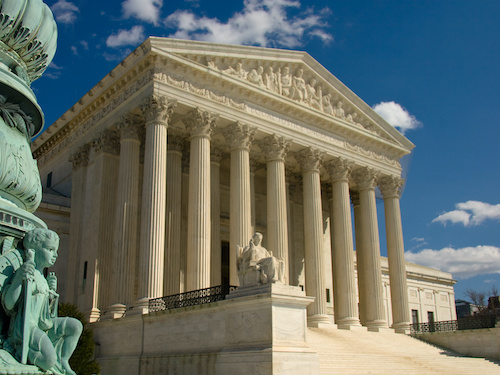Back When the Supreme Court Got It Right On IP: Kewanee, 50 Years Later
“In deciding Kewanee, the Supreme Court didn’t just preserve trade secret law; it restored to it a measure of respectability.”
“The possibility that an inventor who believes his invention meets the standard of patentability will sit back [and] rely on trade secret law . . . is remote indeed.”
— Justice Burger, for the majority in Kewanee v. Bicron (1974)
When May rolls around, lots of people – well, trade secret people that is – think about the Defend Trade Secrets Act of 2016 (DTSA), which for the first time in U.S. history granted original jurisdiction in federal courts for civil claims of misappropriation. The DTSA was signed into law on May 11, 2016, so it’s now eight years old. And performing pretty much as Congress intended.
But this year there’s a far more consequential anniversary to celebrate. May 13 marks 50 years since the U.S. Supreme Court issued its 1974 opinion in Kewanee v. Bicron. I remember that time very well. Barely a year out of law school, I was still learning the ropes of legal practice. While walking down the hall I saw something very unusual: the senior partner sitting at his desk reading one of the “advance sheets.” (Back in pre-internet days, new case opinions were printed in pamphlets and rushed out to lawyers ahead of the bound volumes.)
The Most Important Case of the Century
I had never before seen this partner actually reading a case, so I knew it had to be something important. I stopped and asked what it was about. He just said, “the Supreme Court says trade secret law is okay.” I went on, not knowing what he was talking about. At that time, trade secret law was not taught at law schools. It was only a few years later, as the rapid emergence of Silicon Valley brought me dozens of disputes over engineers departing for competitors, that I began to understand why he had snatched up this report just as soon as it came in. And why Kewanee was undoubtedly the most important trade secret case of the century.
The seeds of this debate had been planted back in 1939, when the American Law Institute (ALI) issued its Restatement of Torts. As the name suggests, the nominal purpose of that work was to summarize for lawyers and courts the common law, as reflected in decades of decisions in individual cases from state courts. Where trade secrets were concerned, however, the ALI did not so much restate as reframe the law as it ought to be, according to the views of a few professors. How that came to be is an intriguing story, to be told another time.
This reframing began with putting trade secret law in its place relative to its statutory cousin patent law; only the latter was directed at incentivizing innovation; secrecy was just about protecting a private transaction. The Restatement went even further, denying the status of trade secrets as “property” (reversing the common law consensus) and limiting their scope to a process or device “in continuous use” in a business. No longer protected, except against deliberate espionage, were secret bids or marketing plans, or any of a company’s records of experimentation. This cramped scope of trade secret rights represented a sea change from the common law, and courts responded by creating a new, separate category to protect mere “confidential” information that didn’t “rise to the level” of a trade secret.
Trade Secret Law, Weakened and Vulnerable
Trade secret law hobbled along this way for years, walking on two different legs. In this weakened state, it provoked the question whether it should even exist in the company of the more refined and majestic federal patent law, which was recognized as a spur to innovation and which benefited the public by required disclosure of inventions. Trade secrets, in contrast, developed an image of smoky back room deals among unsavory characters.
If that is a bit of overstatement for dramatic effect, it can’t be denied that the sharp knives were coming out. The drama began to unfold in 1964, when the Supreme Court decided a pair of cases, Sears, Roebuck & Co. v. Stiffel, and Compco Corp. v. Day-Brite Lighting. Emphasizing that the Constitution gave Congress the exclusive power to legislate in the field of patents and copyrights, the court invalidated state laws declaring it a form of “unfair competition” to copy an item on sale in the open market. Since trade secret misappropriation was seen as a type of unfair competition, academics suggested that it too should be “pre-empted” by patent law.
In 1973, the Sixth Circuit agreed with this argument in the Kewanee case, and because other courts had come to a different conclusion, the Supreme Court agreed to review it. Looking back from the vantage point of modern trade secret law, it might seem bizarre even to question whether trade secrets had a right to exist. As you already know from the spoiler, the Supreme Court got it right, declaring trade secrets to be no “obstacle” to the purposes of the patent law. But the decision wasn’t unanimous; two justices dissented. And the majority’s primary reasoning was flawed.
Bad Logic, Good Result
Justice Burger authored the opinion, first pointing out that as a form of protection trade secrets were “far weaker” than patents because they did not bar independent discovery by another. “Where patent law acts as a barrier, trade secret law functions relatively as a sieve.” He then described three ways to view an invention: clearly patentable, clearly not patentable, or of “dubious” patentability. The second and third categories were easily disposed of as beyond the public interest, while only the first presented a serious question of interfering with the objectives of the federal law. But in that situation, he explained, the possibility that an inventor would choose the “weaker” form was “remote indeed.” (It’s surprising that no one seemed to have informed the Court that companies with patentable processes had long opted for secrecy over patenting, in part because discovering secret infringement is difficult, and in part because secrets have an indefinite life. DuPont, for example, protected its chloride process for producing titanium dioxide as a secret for decades beyond when the patent would have expired. This is something familiar to me, as the house where I grew up was just a few miles from the DuPont factory, and its dust regularly settled on our neighborhood).
The majority’s wobbly logic about an inventor’s preferences wasn’t the only justification offered, however. Justice Marshall, concurring in the result, articulated a much simpler and more compelling reason: Congress had frequently amended the patent statute over the years while being fully aware of state trade secret law; its silence reflected an acceptance that the two regimes were complementary.
In deciding Kewanee, the Supreme Court didn’t just preserve trade secret law; it restored to it a measure of respectability. The Court directly contradicted the Restatement by declaring that one of the two pillars of trade secret policy (along with maintenance of commercial ethics) was the “encouragement” of invention – putting trade secrets closer to a place of honor equivalent to patents.
The Supreme Court Continues to Get It Right on Trade Secrets
In cases decided since Kewanee, the Court continued to be kind to trade secret law. Aaronson v. Quick Point Pencil Co. enforced continuing royalties after rejection of a patent application because the licensee had bargained for an early look at the technology while still a secret. In Ruckelshaus v. Monsanto Co. and Carpenter v. United States it confirmed that trade secrets are, after all, a form of “property.” And in Bonito Boats, Inc. v. Thunder Craft Boats, Inc., it emphasized that products available on the open market can be reverse engineered, despite contrary state laws.
In the meantime, the Uniform Trade Secrets Act was proposed, and the states steadily adopted it (or some form of it), grounding the law in statutes. The old Restatement view that only secrets “in continuous use” could be protected was discarded, in favor of the much broader measure of information of “actual or potential value” to the business. And all that “confidential information” that was supposed to “rise” like warm bread was now fully within the definition of trade secrets.
With all the patent reforms wrought in 2011 by the America Invents Act, you would have been excused for missing its two major provisions that have since reduced “trade secret hesitancy” in companies: first, the “best mode” requirement that led to pouring secrets into patent applications to avoid invalidity is now toothless; and second, the prior user right now universally protects against the threat of being blocked by a later inventor.
Patents, Not So Much
All of this has led to a widespread increase in focus on trade secrets as a corporate strategy. Ironically, and distressingly, at the same time the Supreme Court in a string of decisions has been diminishing, if not dismantling, the power of patents, by limiting allowable subject matter and making enforcement more difficult. We can only hope for a reset at the Court, or enlightened action by Congress.
As for trade secrets, it’s been some time since the Court has taken on a case, and honestly, I’m not sure I want to see that happen, given its current views about intellectual property. Nevertheless, we should all be deeply grateful that back in 1974 it saved trade secret law, even if its reasoning wasn’t perfect. Happy anniversary!
Image rights acquired through AdobeStock.






